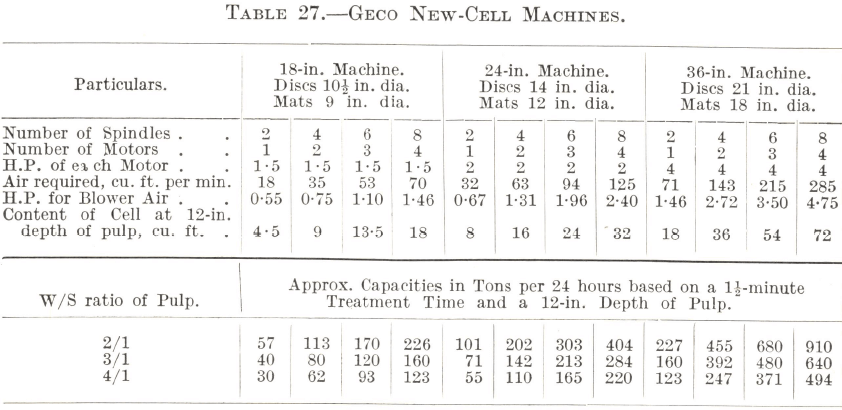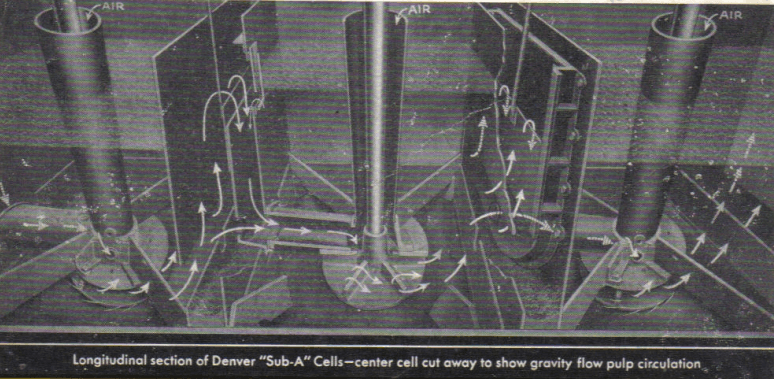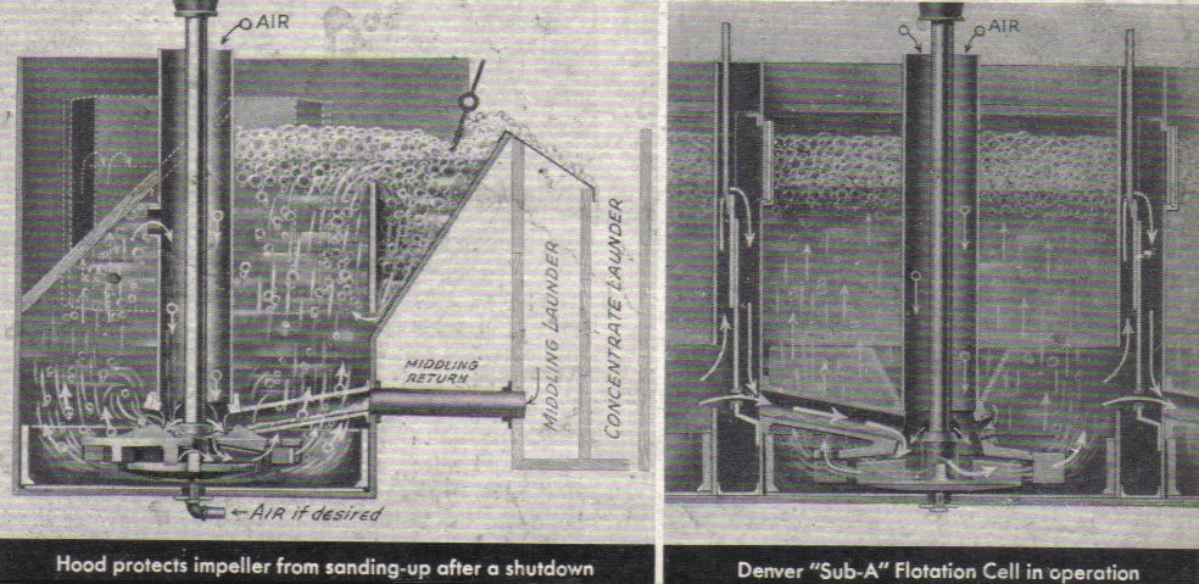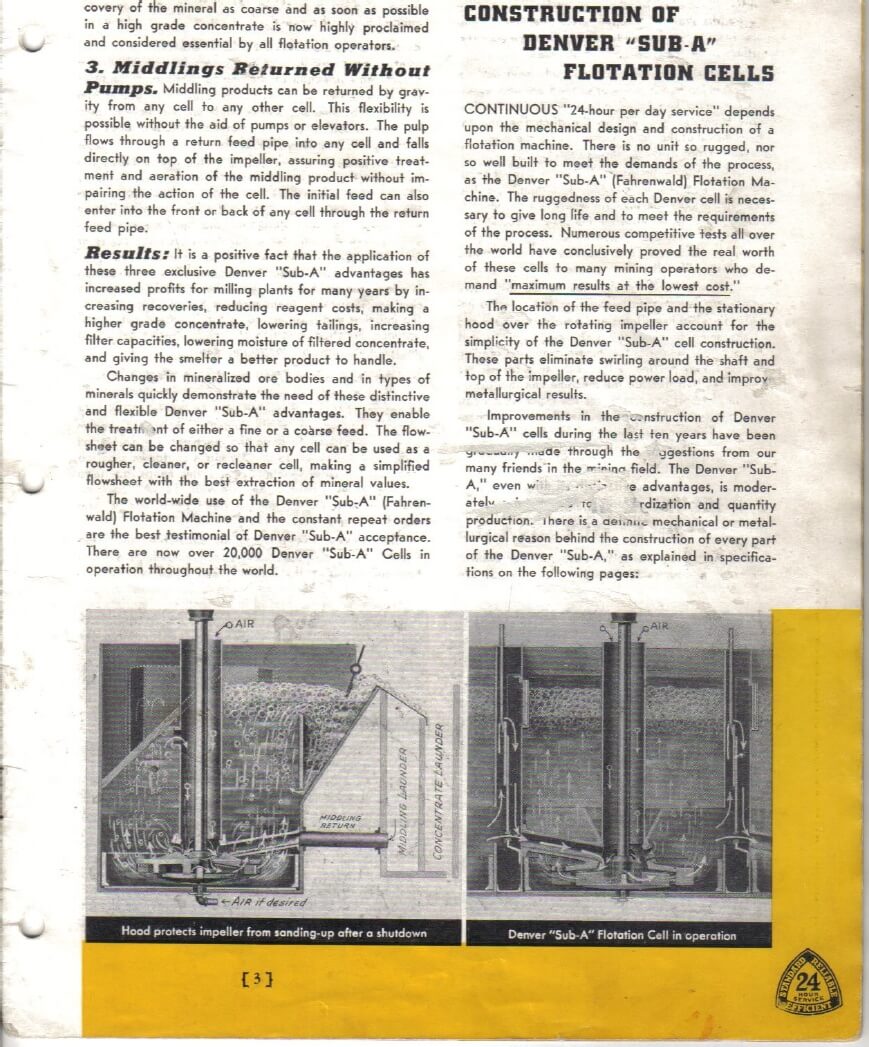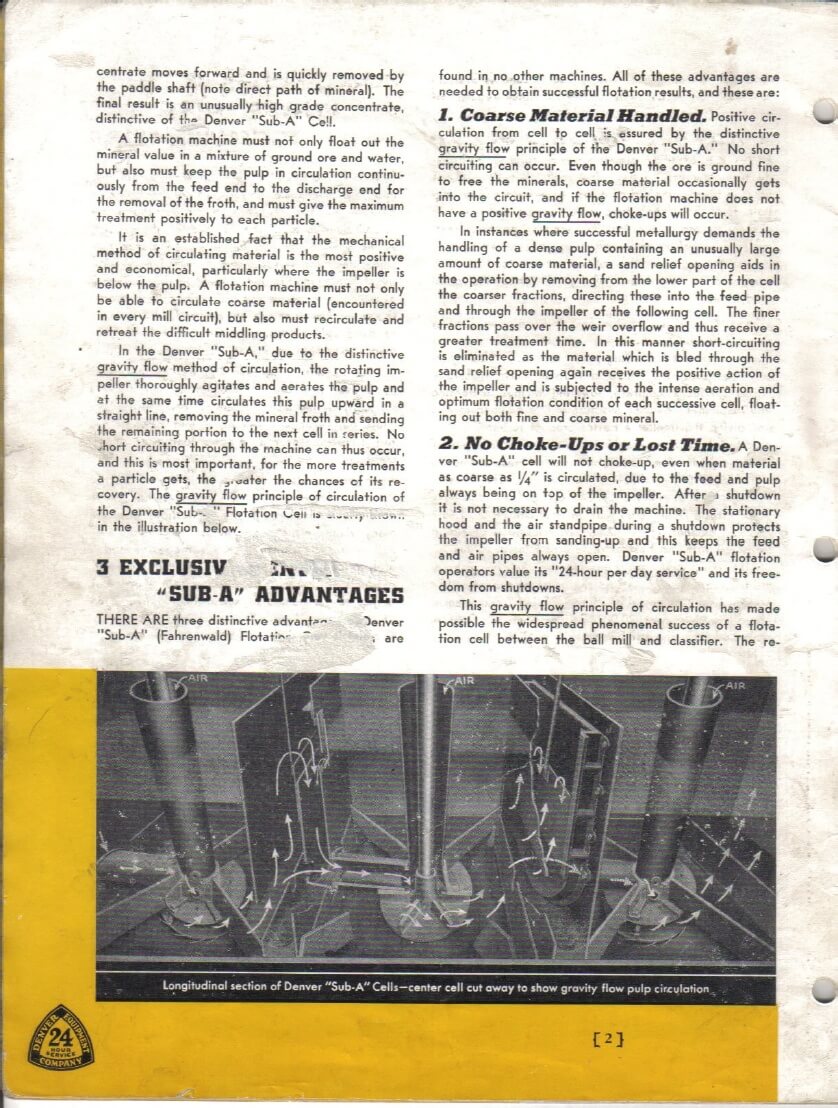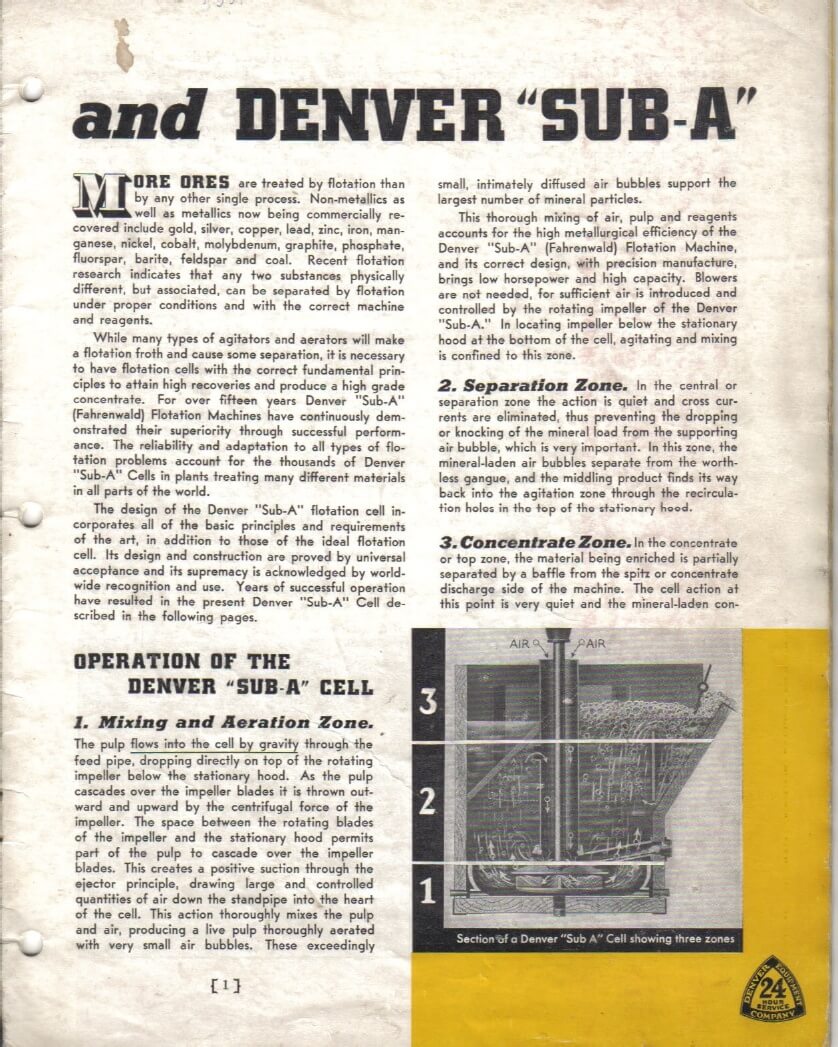Table of Contents
More ores are treated using froth flotation cells than by any other single machines or process. Non-metallics as well as metallics now being commercially recovered include gold, silver, copper, lead, zinc, iron, manganese, nickel, cobalt, molybdenum, graphite, phosphate, fluorspar, barite, feldspar and coal. Recent flotation research indicates that any two substances physically different, but associated, can be separated by flotation under proper conditions and with the correct machine and reagents. The DR flotation machine competes with Wemco and Outotec (post-outokumpu) flotation cells but are all similar is design. How do flotation cells and machine work for the mineral processing industry will be better understood after you read on.
While many types of agitators and aerators will make a flotation froth and cause some separation, it is necessary to have flotation cells with the correct fundamental principles to attain high recoveries and produce a high grade concentrate. The “Sub-A” (Fahrenwald) Flotation Machines have continuously demonstrated their superiority through successful performance. The reliability and adaptations to all types of flotation problems account for the thousands of “Sub-A” Cells in plants treating many different materials in all parts of the world.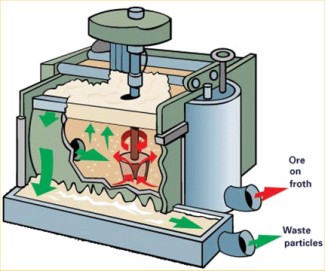
The design of Denver “Sub-A” flotation cells incorporates all of the basic principles and requirements of the art, in addition to those of the ideal flotation cell. Its design and construction are proved by universal acceptance and its supremacy is acknowledged by world-wide recognition and use.
1) Mixing and Aeration Zone: The pulp flows into the cell by gravity through the feed pipe, dropping directly on top of the rotating impeller below the stationary hood. As the pulp cascades over the impeller blades it is thrown outward and upward by the centrifugal force of the impeller. The space between the rotating blades of the impeller and the stationary hood permits part of the pulp to cascade over the impeller blades. This creates a positive suction through the ejector principle, drawing large and controlled quantities of air down the standpipe into the heart of the cell. This action thoroughly mixes the pulp and air, producing a live pulp thoroughly aerated with very small air bubbles. These exceedingly small, intimately diffused air bubbles support the largest number of mineral particles.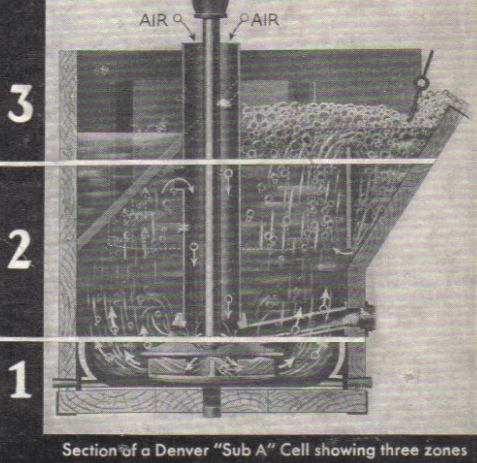
This thorough mixing of air, pulp and reagents accounts for the high metallurgical efficiency of the “Sub-A” (Fahrenwald) Flotation Machine, and its correct design, with precision manufacture, brings low horsepower and high capacity. Blowers are not needed, for sufficient air is introduced and controlled by the rotating impeller of the Denver “Sub-A.” In locating impeller below the stationary hood at the bottom of the cell, agitating and mixing is confined to this zone.
2) Separation Zone: In the central or separation zone the action is quite and cross currents are eliminated, thus preventing the dropping or knocking of the mineral load from the supporting air bubble, which is very important. In this zone, the mineral-laden air bubbles separate from the worthless gangue, and the middling product finds its way back into the agitation zone through the recirculation holes in the top of the stationary hood.
3) Concentrate Zone: In the concentrate or top zone, the material being enriched is partially separated by a baffle from the spitz or concentrate discharge side of the machine. The cell action at this point is very quiet and the mineral-laden concentrate moves forward and is quickly removed by the paddle shaft (note direct path of mineral). The final result is an unusually high grade concentrate, distinctive of the “Sub-A” Cell.
A flotation machine must not only float out the mineral value in a mixture of ground ore and water, but also must keep the pulp in circulation continuously from the feed end to the discharge end for the removal of the froth, and must give the maximum treatment positively to each particle.
It is an established fact that the mechanical method of circulating material is the most positive and economical, particularly where the impeller is below the pulp. A flotation machine must not only be able to circulate coarse material (encountered in every mill circuit), but also must recirculate and retreat the difficult middling products.
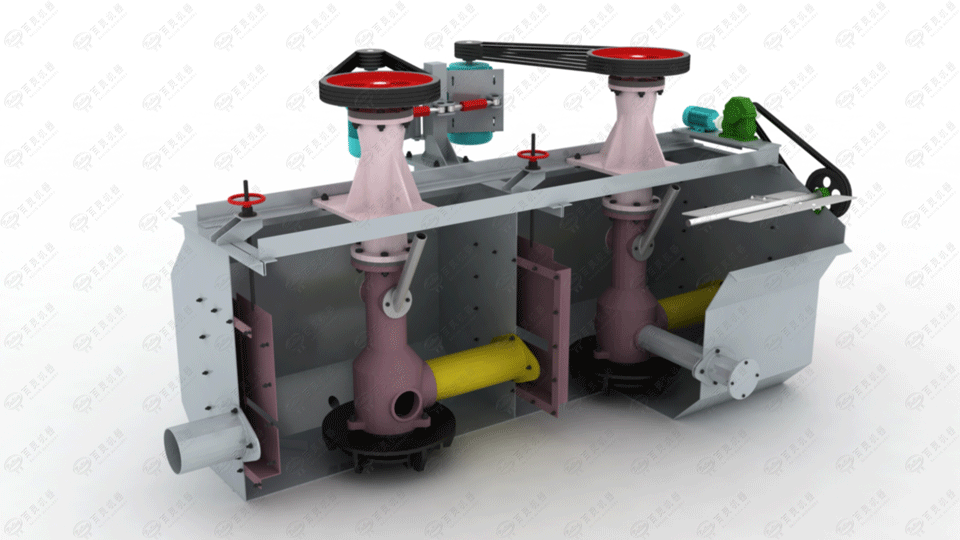
In the Denver “Sub-A” due to the distinctive gravity flow method of circulation, the rotating impeller thoroughly agitates and aerates the pulp and at the same time circulates this pulp upward in a straight line, removing the mineral froth and sending the remaining portion to the next cell in series. No short circuiting through the machine can thus occur, and this is most important, for the more treatments a particle gets, the greater the chances of its recovery. The gravity flow principle of circulation of Denver “Sub-A” Flotation Cell is clearly shown in the illustration below.
There are three distinctive advantages of the “Sub-A” Fahrenwald Flotation Machines are found in no other machines. All of these advantages are needed to obtain successful flotation results, and these are:
Coarse Material Handled: Positive circulation from cell to cell is assured by the distinctive gravity flow principle of the Denver “Sub-A.” No short circuiting can occur. Even though the ore is ground fine to free the minerals, coarse materials occasionally gets into the circuit, and if the flotation machine does not have a positive gravity flow, choke-ups will occur.
In instances where successful metallurgy demands the handling of a dense pulp containing an unusually large amount of coarse material, a sand relief opening aids in the operation by removing from the lower part of the cell the coarser functions, directing these into the feed pipe and through the impeller of the flowing cell. The finer fraction pass over the weir overflow and thus receive a greater treatment time. In this manner short-circuiting is eliminated as the material which is bled through the sand relief opening again receives the positive action of the impeller and is subjected to the intense aeration and optimum flotation condition of each successive cell, floating out both fine and coarse mineral.
No Choke-Ups or Lost Time: A “Sub-A” flotation cell will not choke-up, even when material as coarse as ¼” is circulated, due to the feed and pulp always being on top of the impeller. After the shutdown it is not necessary to drain the machine. The stationary hood and the air standpipe during a shutdown protects the impeller from sanding-up and this keeps the feed and air pipes always open. Denver “Sub-A” flotation operators value its “24-hour per day service” and its freedom from shutdowns.
This gravity flow principle of circulation has made possible the widespread phenomenal success of a flotation cell between the ball mill and classifier. The recovery of the mineral as coarse and as soon as possible in a high grade concentrate is now highly proclaimed and considered essential by all flotation operators.
Middlings Returned Without Pumps: Middling products can be returned by gravity from any cell to any other cell. This flexibility is possible without the aid of pumps or elevators. The pulp flows through a return feed pipe into any cell and falls directly on top of the impeller, assuring positive treatment and aeration of the middling product without impairing the action of the cell. The initial feed can also enter into the front or back of any cell through the return feed pipe.
Results : It is a positive fact that the application of these three exclusive Denver “Sub-A” advantages has increased profits from milling plants for many years by increasing recoveries, reducing reagent costs, making a higher grade concentrate, lowering tailings, increasing filter capacities, lowering moisture of filtered concentrate and giving the smelter a better product to handle.
Changes in mineralized ore bodies and in types of minerals quickly demonstrate the need of these distinctive and flexible Denver “Sub-A” advantages. They enable the treatment of either a fine or a coarse feed. The flowsheet can be changed so that any cell can be used as a rougher, cleaner, or recleaner cell, making a simplified flowsheet with the best extraction of mineral values.
The world-wide use of the Denver “Sub-A” (Fahrenwald) Flotation Machine and the constant repeat orders are the best testimonial of Denver “Sub-A” acceptance. There are now over 20,000 Denver “Sub-A” Cells in operation throughout the world.
There is no unit so rugged, nor so well built to meet the demands of the process, as the Denver “Sub-A” (Fahrenwald) Flotation Machine. The ruggedness of each cell is necessary to give long life and to meet the requirements of the process. Numerous competitive tests all over the world have conclusively proved the real worth of these cells to many mining operators who demand “maximum result at the lower cost.”
The location of the feed pipe and the stationary hood over the rotating impeller account for the simplicity of the Denver “Sub-A” cell construction. These parts eliminates swirling around the shaft and top of the impeller, reduce power load, and improve metallurgical results.
Flotation Cell Design and Flotation Flowsheets
The “Sub-A” Operates in three zones: in bottom zone, impeller thoroughly mixes and aerates the pulp, the central zone separates the mineral laden particles from the worthless gangue, and in top zone the mineral laden concentrate high in grade, is quickly removed by the paddle of a Denver “Sub-A” Cell.
A Positive Cell Circulation is always present in the “Sub-A” (Fahrenwald) Flotation Machine, the gravity flour method of circulating pulp is distinctive. There is no short circulating through the machine. Every Cell must give maximum treatment, as pulp falls on top of impeller and is aerated in each cell repeatedly. Note gravity flow from cell to cell.
Choke-Ups Are Eliminated in the “Sub-A” Cell, even when material as coarse as ¼ is handled, due to the gravity flow principle of circulation. After shutdown it is not necessary to drain the machine, as the stationary hood protects impeller from sanding up. See illustration at left showing cell when shut down.
No Bowlers, no air under pressure is required as sufficient air is drawn down the standpipe. The expense and complication of blowers, air pipes and valves are thus eliminated. The standpipe is a vertical air to the heart of the Cell, the impeller. Blower air can be added if desired.
The “Sub-A” Flexibility allows it to be used as a rougher, cleaner or recleaner. Rougher or middling product can be returned to the front or back of any cell by gravity without the use of pumps or elevators. Cells can be easily added when required. This flexibility is most important in operating flotation MILLS.
Pulp Level Is Controlled in each “Sub-A” Flotation Cell as it has an individual machine with its own pulp level control. Correct flotation requires this positive pulp level control to give best results in these Cells weir blocks are used, but handwheel controls can be furnished at a slight increase in cost. Note the weir control in each cell.
High Grade Concentrate caused by the quick removal of the mineral forth in the form of a concentrate increases the recovery. By having an adjustment paddle for each “Sub-A” Cell, quick removal of concentrate is assured, Note unit bearing housing for the impeller Shaft and Speed reducer drive which operates the paddle for each cell
Has Fewer Wearing Parts because “Sub-A” Cells are built for long, hard service, and parts subject to wear are easily replaced at low cost. Molded rubber wearing plates and impellers are light in weight give extra long life, and lower horsepower. These parts are made under exact Specifications and patented by Denver Equipment Co.
New Impeller and Diffuser: New receded disk impeller with diffuser has the following advantages:
- Horsepower further reduced.
- Increased aeration due to finer diffusion of air.
- Quiet froth bed.
- Higher grade concentrate and lower flotation tailing.
The Rugged Construction of the “Sub-A” tank is made of heavy steel, and joints are welded both inside and out. The shaft assemblies are bolted to a heavy steel beam which is securely connected to the tank. Partition plates can be changed in the field for right or left hand machine. Right hand machine is standard.
Flotation machines can be divided into three classes, comprising respectively mechanically-agitated, air-lift or matless, and pneumatic machines.
Minerals Separation Sub-aeration Flotation Cells
The Minerals Separation or M.S. Sub-aeration cells, a section of which is shown in Fig. 32, consists essentially of a series of square cells with an impeller rotating on a vertical shaft in the bottom of each. In some machines the impeller is cruciform with the blades inclined at 45°, the top being covered with a flat circular plate which is an integral part of the casting, but frequently an enclosed pump impeller is used with curved blades set at an angle of 45° and with a central intake on the underside ; both patterns are rotated so as to throw the pulp upwards. Two baffles are placed diagonally in each cell above the impeller to break up the swirl of the pulp and to confine the agitation to the lower zone. Sometimes the baffles are covered with a grid consisting of two or three layers each composed of narrow wood or iron strips spaced about an inch apart. The sides and bottom of the cells in the lower or agitation zone are protected from wear by liners, which are usually made of hard wood, but which can, if desired, consist of plates of cast-iron or hard rubber. The section directly under the impeller is covered with a circular cast-iron plate with a hole in the middle for the admission of pulp and air. The hole communicates with a horizontal transfer passage under the bottom liner, through which the pulp reaches the cell. Air is introduced into each cell through a pipe passing through the bottom and delivering its supply directly under the impeller. A low-pressure blower is provided with all machines except the smallest, of which the impeller speed is fast enough to draw in sufficient air by suction for normal requirements.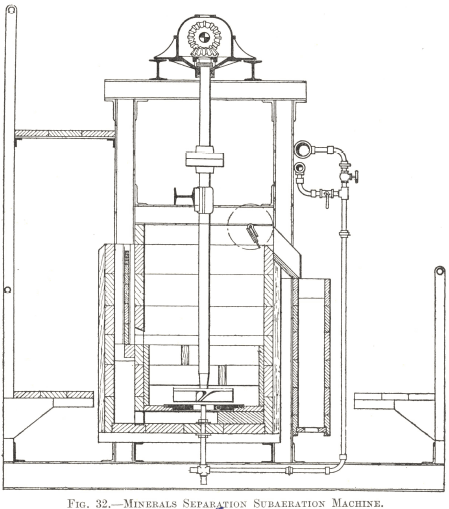
The pulp is fed to the first cell through a feed opening communicating with the transfer passage, along which it passes, until, at the far end, it is drawn up through the hole in the bottom liner by the suction of the impeller and is thrown outwards by its rotation into the lower zone. The square shape of the cell in conjunction with the baffles converts the swirl into a movement of intense agitation, which breaks up the air entering at the same time into a cloud of small bubbles, disseminating them through the pulp. The amount of aeration can be accurately regulated to suit the requirements of each cell by adjustment of the valve on its air pipe.
Contact between the bubbles and the mineral particles probably takes place chiefly in the lower zone. The pumping action of the impeller forces the aerated pulp continuously past the baffles into the upper and quieter part of the cell. Here the bubbles, loaded with mineral, rise more or less undisturbed, dropping out gangue particles mechanically entangled between them and catching on the way up a certain amount of mineral that has previously escaped contact. The recovery of the mineral in this way can be increased at the expense of the elimination of the gangue by increasing the amount of aeration. The froth collects at the top of the cell and is scraped by a revolving paddle over the lip at the side into the concentrate launder. The pulp, containing the gangue and any mineral particles not yet attached to bubbles, circulates to some extent through the zone of agitation, but eventually passes out through a slot situated at the back of the cell above the baffles and flows thence over the discharge weir. The height of the latter is regulated by strips of wood or iron and governs the level of the pulp in the cell. The discharge of each weir falls by gravity into the transfer passage under the next cell and is drawn up as before by the impeller. The pulp passes in this way through the whole machine until it is finally discharged as a tailing, the froth from each cell being drawn off into the appropriate concentrate launder.
No pipes are normally fitted for the transference of froth or other middling product back to the head of the machine or to any intermediate point. Should this be necessary, however, the material can be taken by gravity to the required cell through a pipe, which is bent at its lower end to pass under the bottom liner and project into the transfer passage, thus delivering its product into the stream of pulp that is being drawn up by the impeller
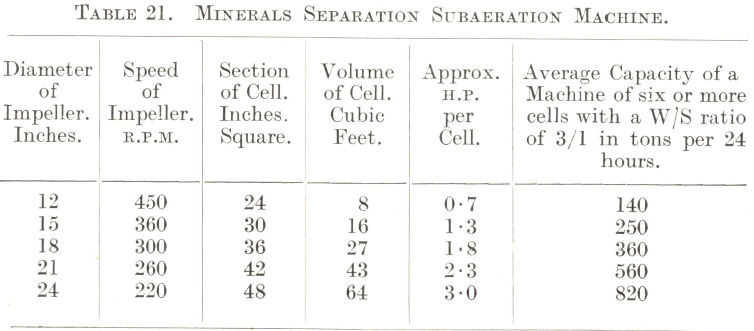
Particulars of the various sizes of M.S. Machines are given in Table 21. It should be noted that the size of a machine is usually defined by the diameter of its impeller ; for instance, the largest one would be described as a “24-inch machine”.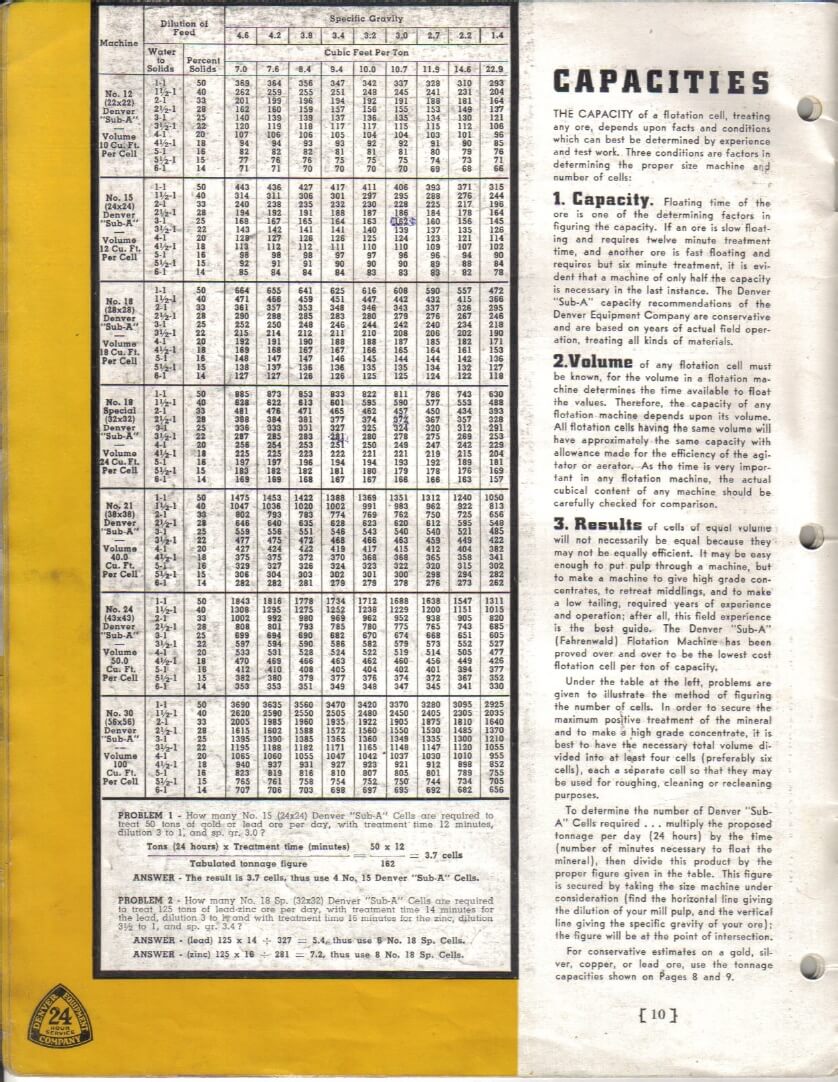
Sub-A Flotation Cells
The “Sub-A” Machine, invented by A. W. Fahrenwald and developed in many respects as an improvement in the Minerals Separation Machine, from which it differs considerably in detail, particularly in the method of aerating the pulp, although the principle of its action is essentially the same. Its construction can be seen from Figs. 33 and 34.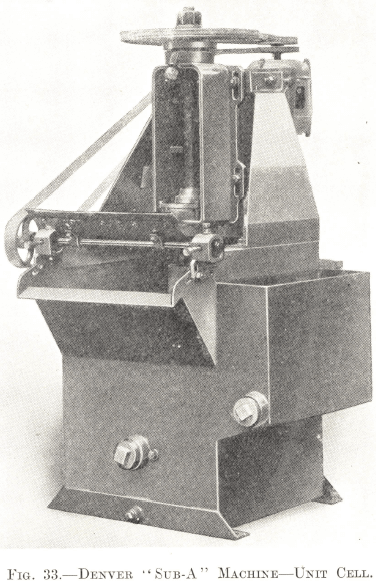
In common with the M.S. type of machine, it consists of a series of square cells fitted with rotating impellers. Each cell, however, is of unit construction, a complete machine being built up by mounting the required number of units on a common foundation and connecting up the pipes which transfer the pulp from one cell to the next. The cells are constructed of welded steel. The impeller, which can be rubber-lined, if required, carries six blades set upright on a circular dished disc, and is securely fixed to the lower end of the vertical driving shaft. It is covered with a stationary hood, to which are attached a stand-pipe, a feed pipe, and the middling return pipes. 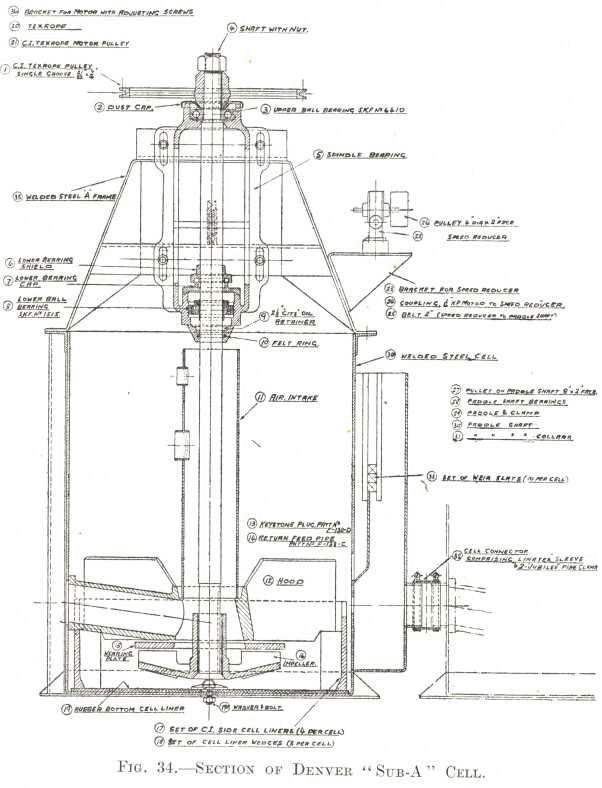 The underside of the hood is fitted with a renewable liner of rubber or cast-iron. The pulp, entering the first cell through the feed pipe and sometimes through the middling pipes, falls on to the impeller, the rotation of which throws it outwards into the bottom zone of agitation. The suction effect due to the rotation of the impeller draws enough air down the standpipe to supply the aeration necessary for normal operation. A portion of the pulp, cascading over the open tops of the impeller blades, entraps and breaks up the entrained air, the resulting spray-like mixture being then thrown out into the lower zone of agitation, where it is disseminated through the pulp as a cloud of fine bubbles. Should this amount of aeration be insufficient, air can be blown in under slight pressure through a hole near the top of the stand-pipe, in which case a rubber bonnet is fastened to the lower bearing and clamped round the top of the stand-pipe so as to seal the supply from the atmosphere.
The underside of the hood is fitted with a renewable liner of rubber or cast-iron. The pulp, entering the first cell through the feed pipe and sometimes through the middling pipes, falls on to the impeller, the rotation of which throws it outwards into the bottom zone of agitation. The suction effect due to the rotation of the impeller draws enough air down the standpipe to supply the aeration necessary for normal operation. A portion of the pulp, cascading over the open tops of the impeller blades, entraps and breaks up the entrained air, the resulting spray-like mixture being then thrown out into the lower zone of agitation, where it is disseminated through the pulp as a cloud of fine bubbles. Should this amount of aeration be insufficient, air can be blown in under slight pressure through a hole near the top of the stand-pipe, in which case a rubber bonnet is fastened to the lower bearing and clamped round the top of the stand-pipe so as to seal the supply from the atmosphere.
The bottom part of the cell is protected from wear by renewable cast-iron or rubber liners. Four vertical baffles, placed diagonally on the top of the hood, break up the swirl of the pulp and intensify the agitation in the lower zone. The pumping action of the impeller combined with the rising current of air bubbles carries the pulp to the quieter upper zone, where the bubbles, already coated with mineral, travel upwards, drop out many of the gangue particles which may have become entangled with them, and finally collect on the surface of the pulp as a mineralized froth. One side of the cell is sloped outwards so as to form, in conjunction with a vertical baffle, a spitzkasten-shaped zone of quiet settlement, where any remaining particles of gangue that have been caught and held between the bubbles are shaken out of the froth as it flows to the overflow lip at the front of the cell. The baffle prevents rising bubbles from entering the outer zone, thus enabling the gangue material released from the froth to drop down unhindered into the lower zone. A revolving paddle scrapes the froth past the overflow lip into the concentrate launder.
Should the machine be required to handle more than the normal volume of froth, it is built with a spitzkasten zone on both sides of the cell. For the flotation of ores containing very little mineral the spitzkasten is omitted so as to crowd the froth into the smallest possible space, the front of the cell being made vertical for the purpose.
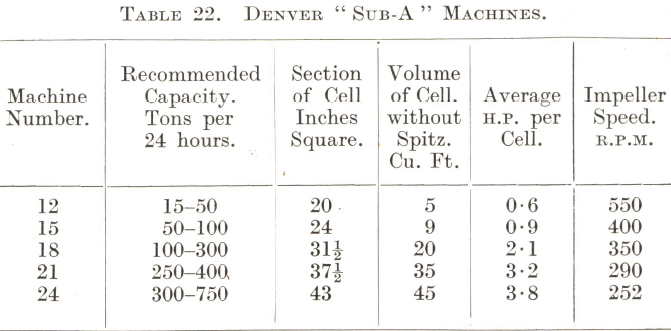
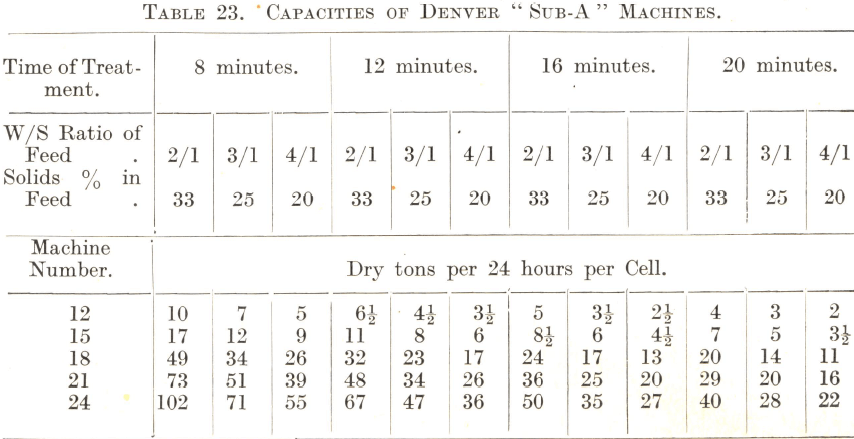
Circulation of the pulp through the lower zone of agitation is maintained by means of extra holes at the base of the stand-pipe on a level with the middling return pipes. An adjustable weir provides for the discharge of the pulp to the next cell, which it enters through a feed-pipe as before. Below the weir on a level with the hood is a small sand hole and pipe through which coarse material can pass direct to the next cell without having to be forced up over the weir. The same process is repeated in each cell of the series, the froth being scraped over the lip of the machine, while the pulp passes from cell to cell until it is finally discharged as a tailing from the last one. The middling pipes make it an easy matter for froth from any section of the machine to be returned if necessary to any cell without the use of pumps.
Table 22 gives particulars of the sizes and power requirements of Denver “Sub-A” Machines and Table 23 is an approximate guide to their capacities under different conditions. The number of cells needed
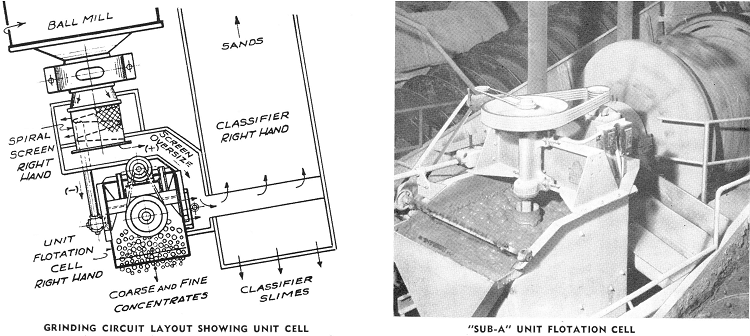
to handle any tonnage can be calculated by dividing the number of tons to be treated per 24 hours by the capacity of one cell as given in Table 23.
Drive of M.S. Sub-aeration and Denver “Sub-A” Flotation Cells
One method of driving the vertical impeller shafts of M.S. Subaeration or Denver “Sub-A” Machines is by “quarter-twist” belts from a horizontal lineshaft at the back of the machine, the lineshaft being driven in turn by a belt from a motor on the ground. This method is not very satisfactory according to modern standards, firstly, because the belts are liable to stretch and slip off, and, secondly, because adequate protection against accidents due to the belts breaking is difficult to provide without making the belts themselves inaccessible. A more satisfactory drive, with which most M.S. Machines are equipped, consists of a lineshaft over the top of the cells from which each impeller is driven through bevel gears. The lineshaft can be driven by a belt from a motor on the ground, by Tex- ropes from one mounted on the frame work of the machine, or by direct coupling to a slow-speed motor. This overhead gear drive needs careful adjustment and maintenance. Although it may run satisfactorily for years, trouble has been experienced at times, generally in plants where skilled mechanics have not been available. The demand for something more easily adjusted led to the development of a special form of Tex-rope drive which is shown in Fig. 35. Every impeller shaft is fitted at the top with a grooved pulley, which is driven by Tex-ropes from a vertical motor. This method is standard on Denver “Sub-A” Machines, and M.S. Machines are frequently equipped with it as well, but the former type are not made with the overhead gear drive except to special order.
Regulation of Mechanically Agitated Flotation Cells
The great advantage of mechanically agitated machines is that every cell can be regulated separately, and that reagents can be added when necessary at any one of them. Since, as a general rule, the most highly flocculated mineral will become attached to a bubble in preference to a less floatable particle, in normal operation the aeration in the first few cells of a machine should not be excessive ; theoretically there should be no more bubbles in the pulp than are needed to bring up the valuable minerals. By careful control of aeration it should be possible for the bulk of the minerals to be taken off the first few cells at the feed end of the machine in a concentrate rich enough to be easily cleaned, and sometimes of high enough grade to be sent straight to the filtering section as a finished product. The level of the pulp in these cells is usually kept comparatively low in order to provide a layer of froth deep enough to give entangled particles of gangue every chance of dropping out, but it must not be so low that the paddles are prevented from skimming off the whole of the top layer of rich mineral. Towards the end of the machine a scavenging action is necessary to make certain that the least possible amount of valuable mineral escapes in the tailing, for which purpose the gates of the discharge weirs are raised higher than at the feed end, and the amount of aeration may have to be increased. The froth from the scavenging cells is usually returned to the head of the machine, the middling pipes of the Denver “Sub-A” Machine being specially designed for such a purpose. The regulation of the cleaning cells is much the same as that of the first few cells of the primary or roughing machine, to the head of which the tailing from the last of the cleaning cells is usually returned.
A blower is sometimes required with the M.S. Subaeration Machine. Since each cell is fitted with an air pipe and valve, accurate regulation of aeration is a simple matter. The Denver “Sub-A”, Kraut, and Fagergren Machines, however, are run without blowers, enough air being drawn into the machines by suction.
Geco Flotation Cells
In the Geco New-Cell Flotation Cell the pneumatic principle is utilized in conjunction with an agitating device. The machine, which is illustrated in Fig. 44, consists of a trough or cell made of steel or wood, whichever is more convenient, through the bottom of which projects a series of air pipes fitted with circular mats of perforated rubber. The method of securing the mat to the air pipe can be seen from Fig. 45. Over each mat rotates a moulded rubber disc of slightly larger diameter at a peripheral speed of 2,500 ft. per minute. It is mounted on a driving spindle as shown in Fig. 46.
Each spindle is supported and aligned by ball-bearings contained in a single dust- and dirt-proof casting, and each pair is driven from a vertical motor through Tex-ropes and grooved pulleys, a rigid steel structure supporting the whole series of spindles with their driving mechanism. The machine can be supplied, if required, however, with a quarter-twist drive from a lineshaft over flat pulleys.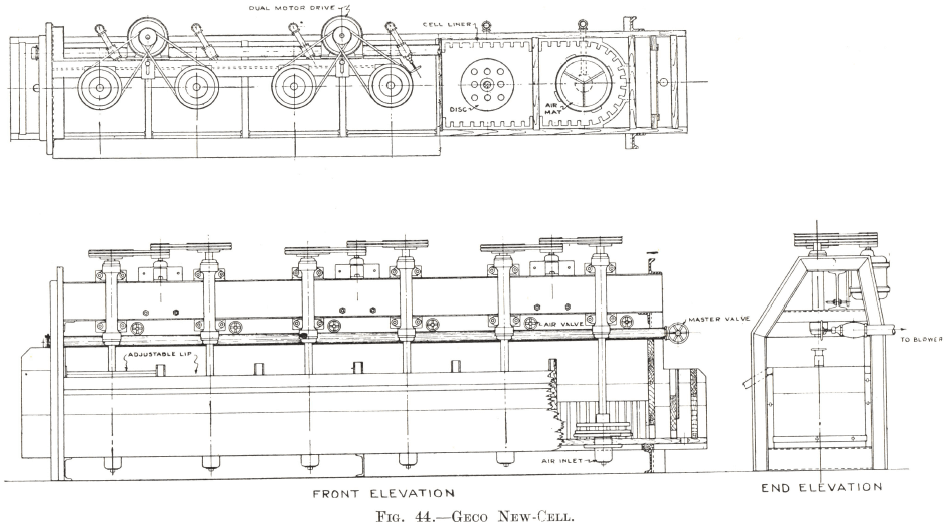
The air inlet pipes are connected to a main through a valve by which the amount of air admitted to each mat can be accurately controlled. The air is supplied by a low-pressure blower working at about 2½ lb. per square inch. It enters the cell through the perforations in the rubber mat and is split up into a stream of minute bubbles, which are distributed evenly throughout the pulp by the action of the revolving disc. By this means a large volume of finely-dispersed air is introduced without excessive agitation. There is sufficient agitation, however, to produce a proper circulation in the cell, but not enough to cause any tendency to surge or to disturb the froth on the surface of the pulp. All swirling movement is checked by the liner-baffles with which the sides of the cell are lined ; their construction can be seen in Fig. 44. They are constructed of white cast iron and are designed to last the life of the machine, the absence of violent agitation making this possible.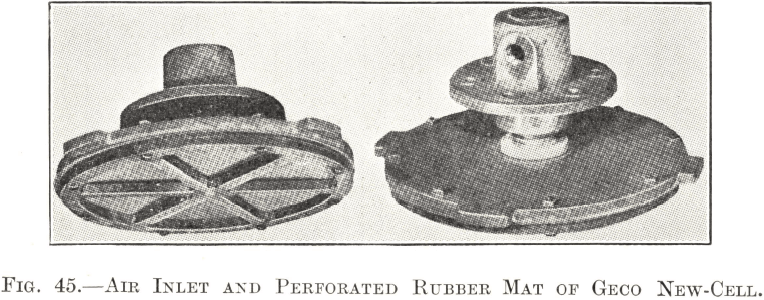 The pulp must be properly conditioned before entering the machine. It is admitted through a feed box at one end at a point above the first disc, and passes along the length of the cell to the discharge weir without being made to pass over intermediate weirs between the discs. The height of the weir at the discharge end thus controls the level of the pulp in the machine. The froth that forms on the surface overflows the froth lip in a continuous stream without the aid of scrapers, its depth being controlled at any point by means of adjustable lip strips combined with regulation of the air.
The pulp must be properly conditioned before entering the machine. It is admitted through a feed box at one end at a point above the first disc, and passes along the length of the cell to the discharge weir without being made to pass over intermediate weirs between the discs. The height of the weir at the discharge end thus controls the level of the pulp in the machine. The froth that forms on the surface overflows the froth lip in a continuous stream without the aid of scrapers, its depth being controlled at any point by means of adjustable lip strips combined with regulation of the air. The Geco New-Cell is made in four sizes—viz., 18-, 24-, 36-, and 48-in. machines, the figure representing the length of the side of the square cell. Particulars of the three smallest sizes are given in Table 27. Figures are not available for the largest size.
The Geco New-Cell is made in four sizes—viz., 18-, 24-, 36-, and 48-in. machines, the figure representing the length of the side of the square cell. Particulars of the three smallest sizes are given in Table 27. Figures are not available for the largest size.
